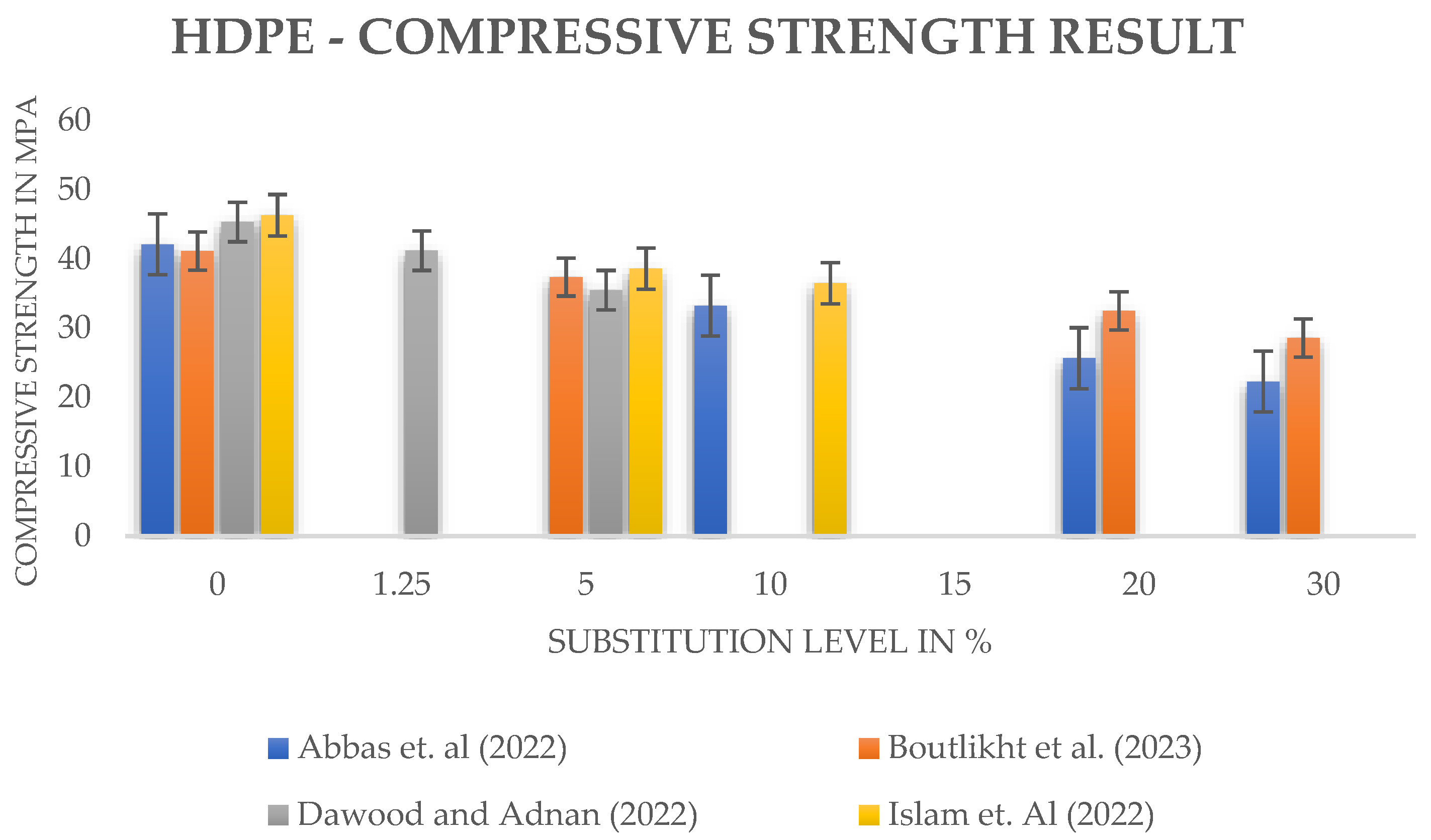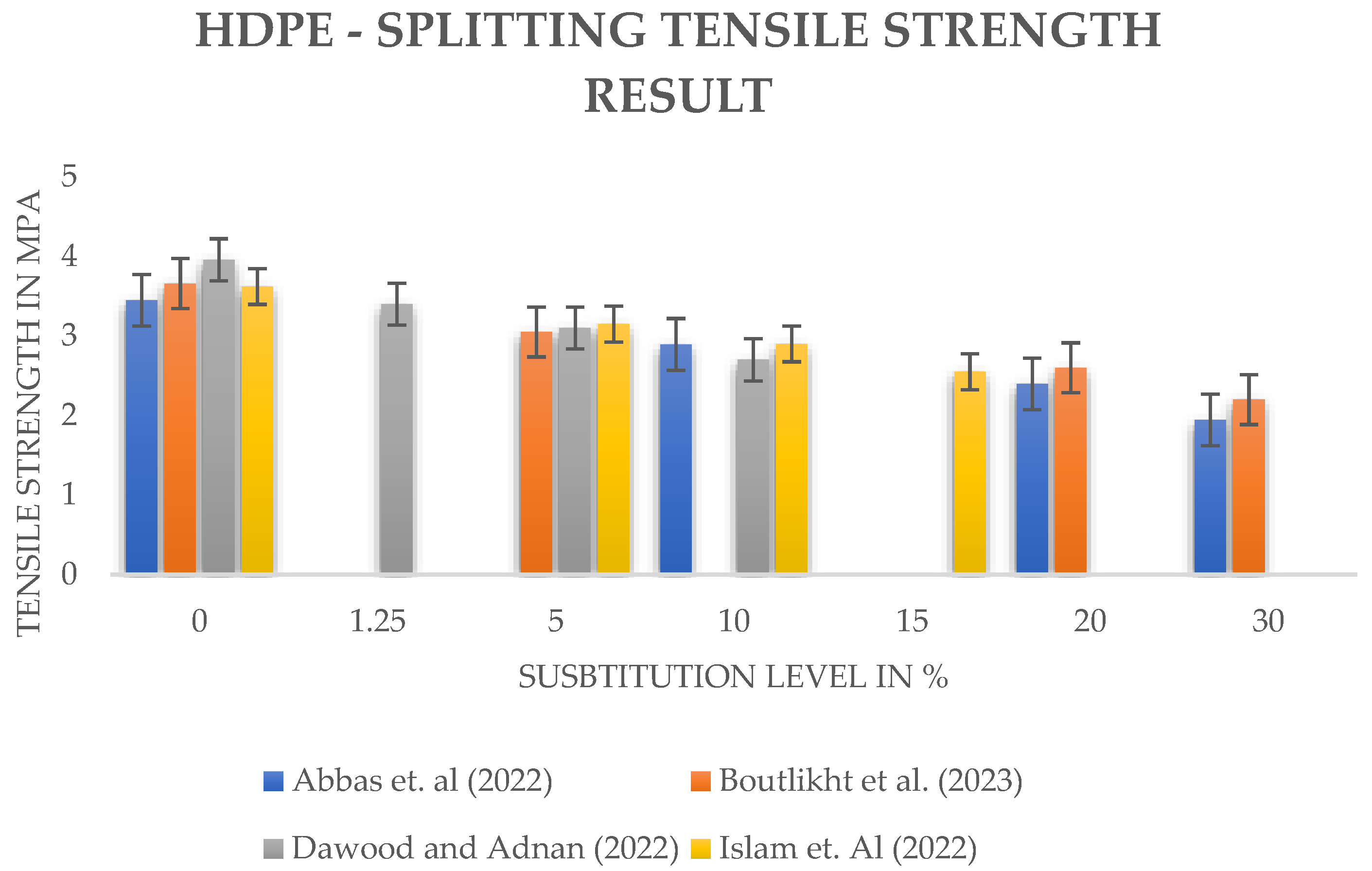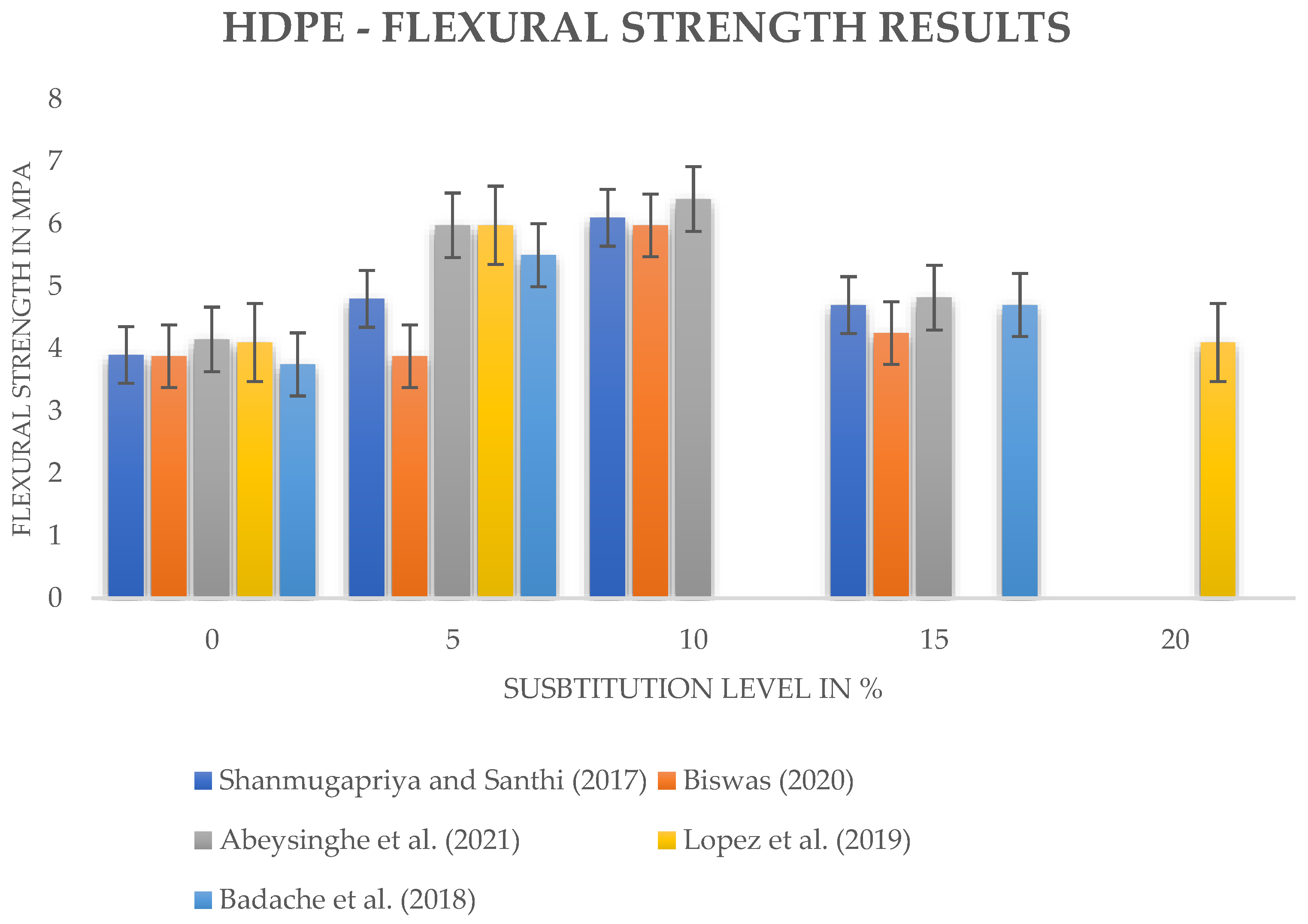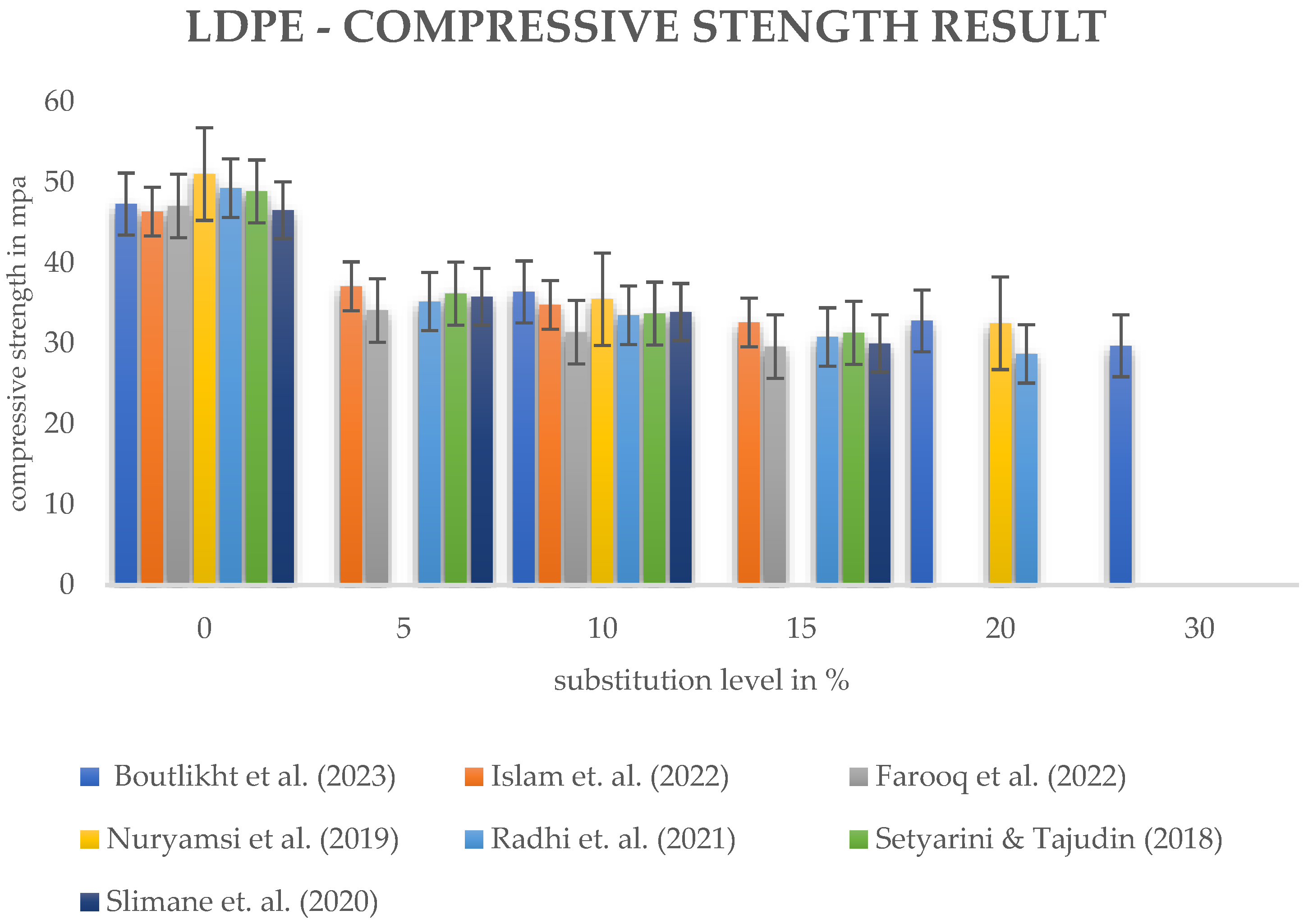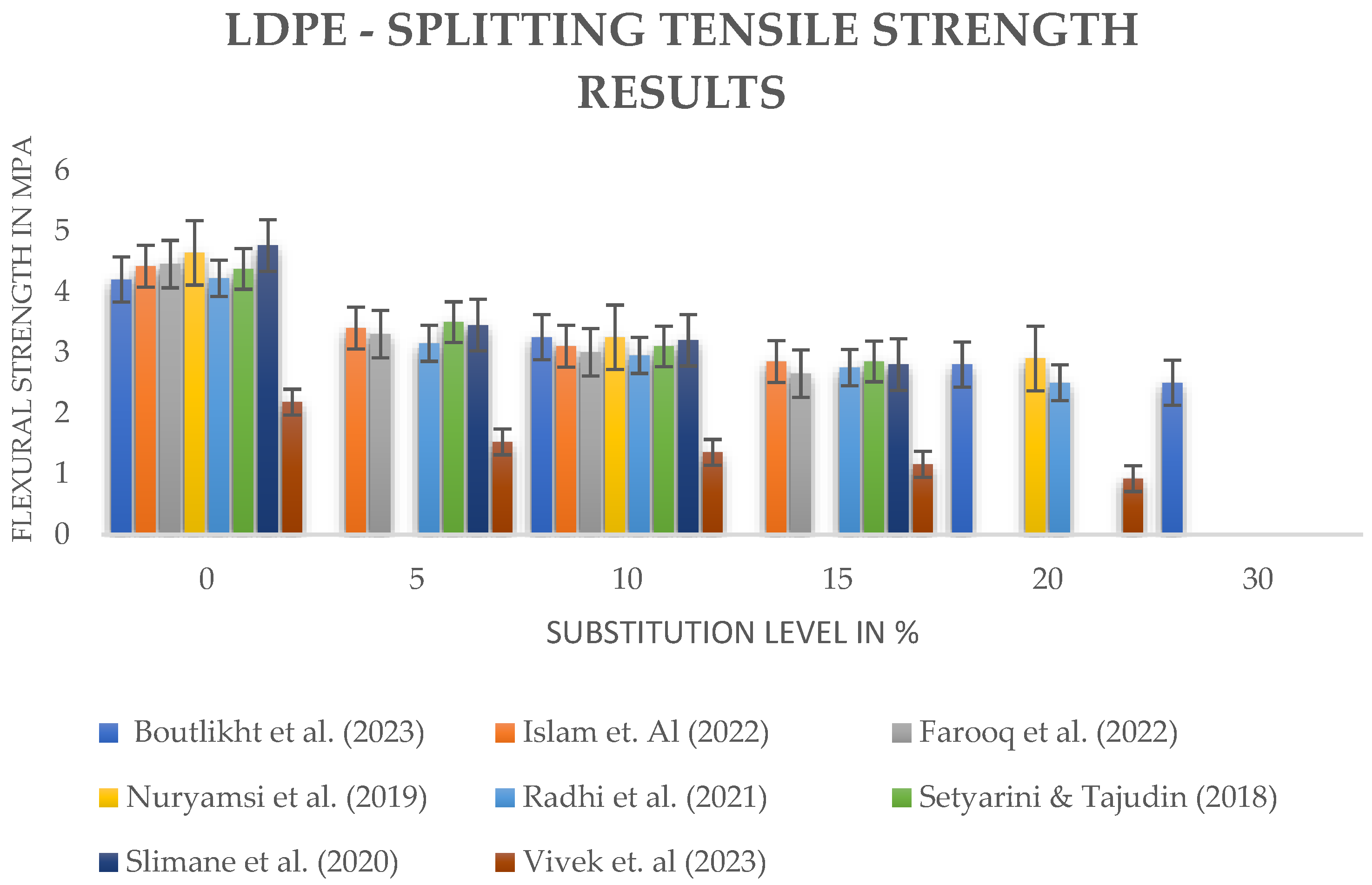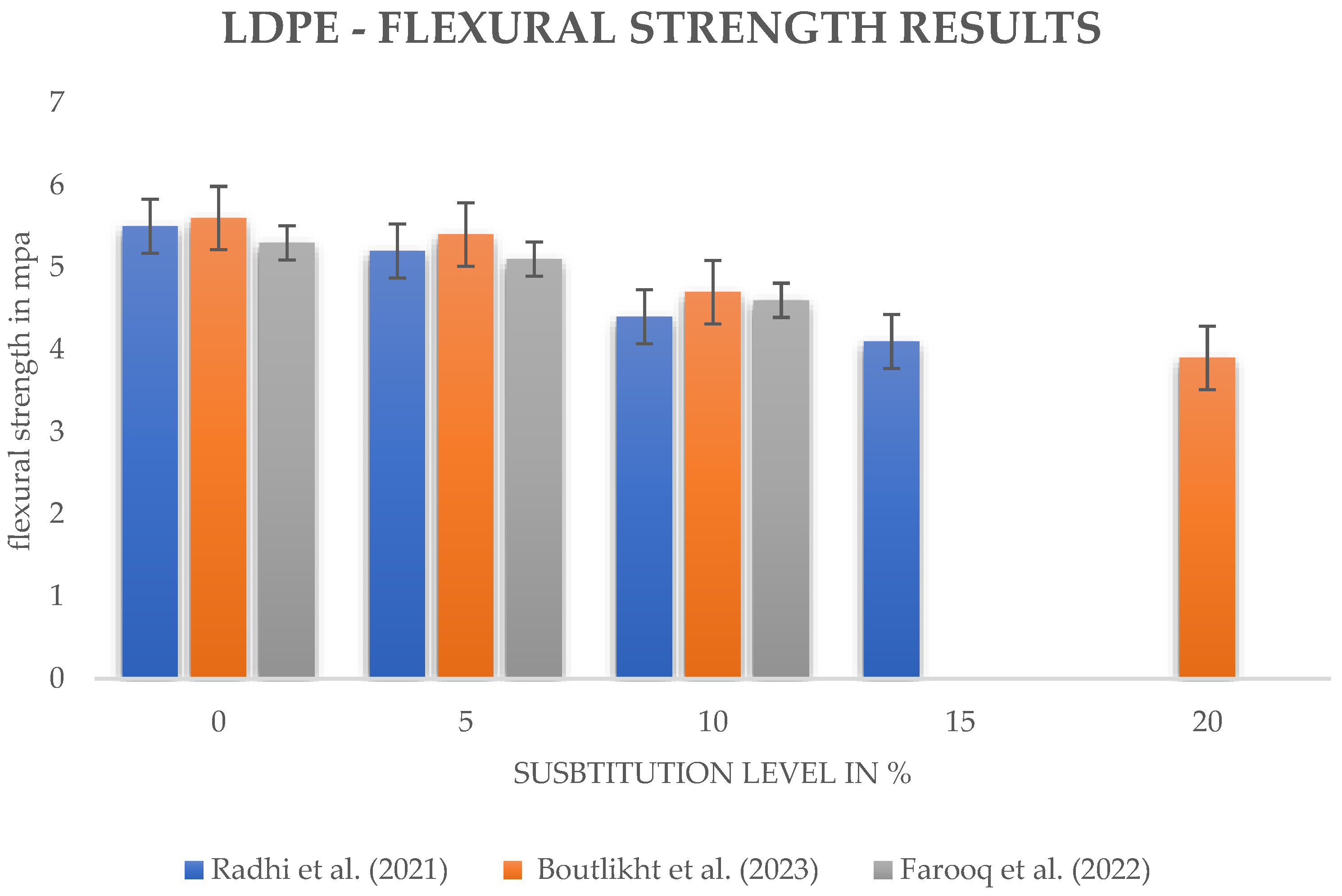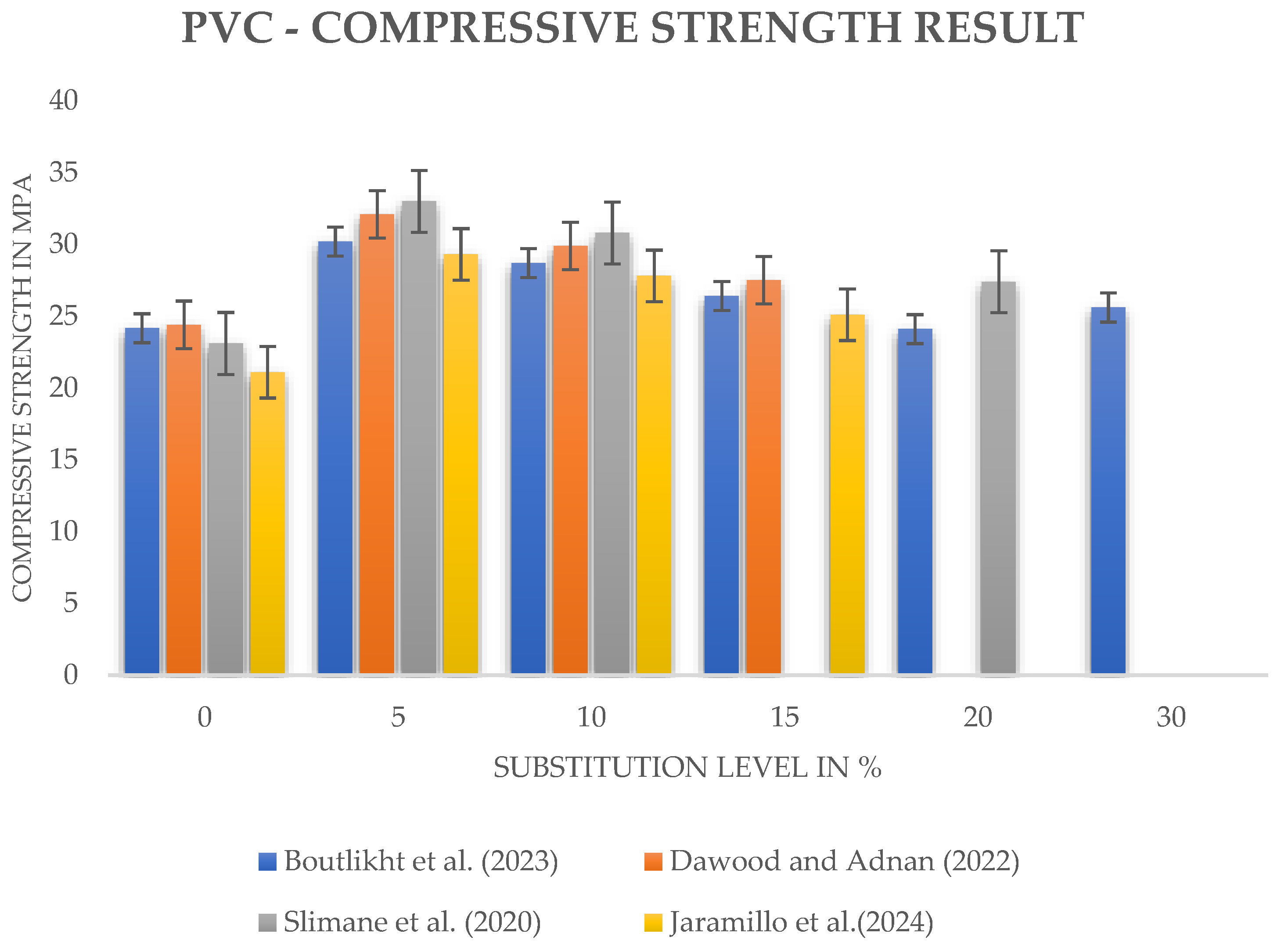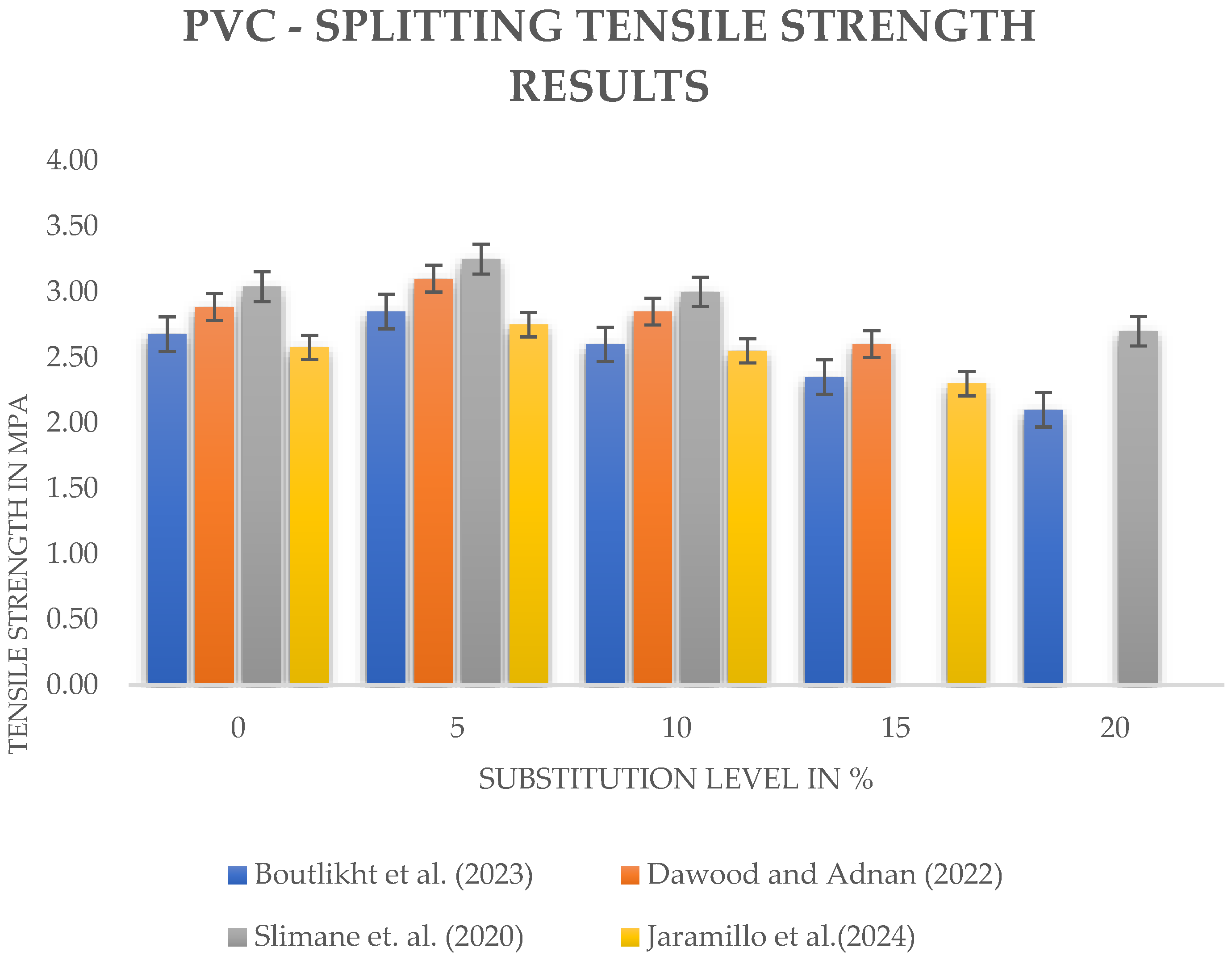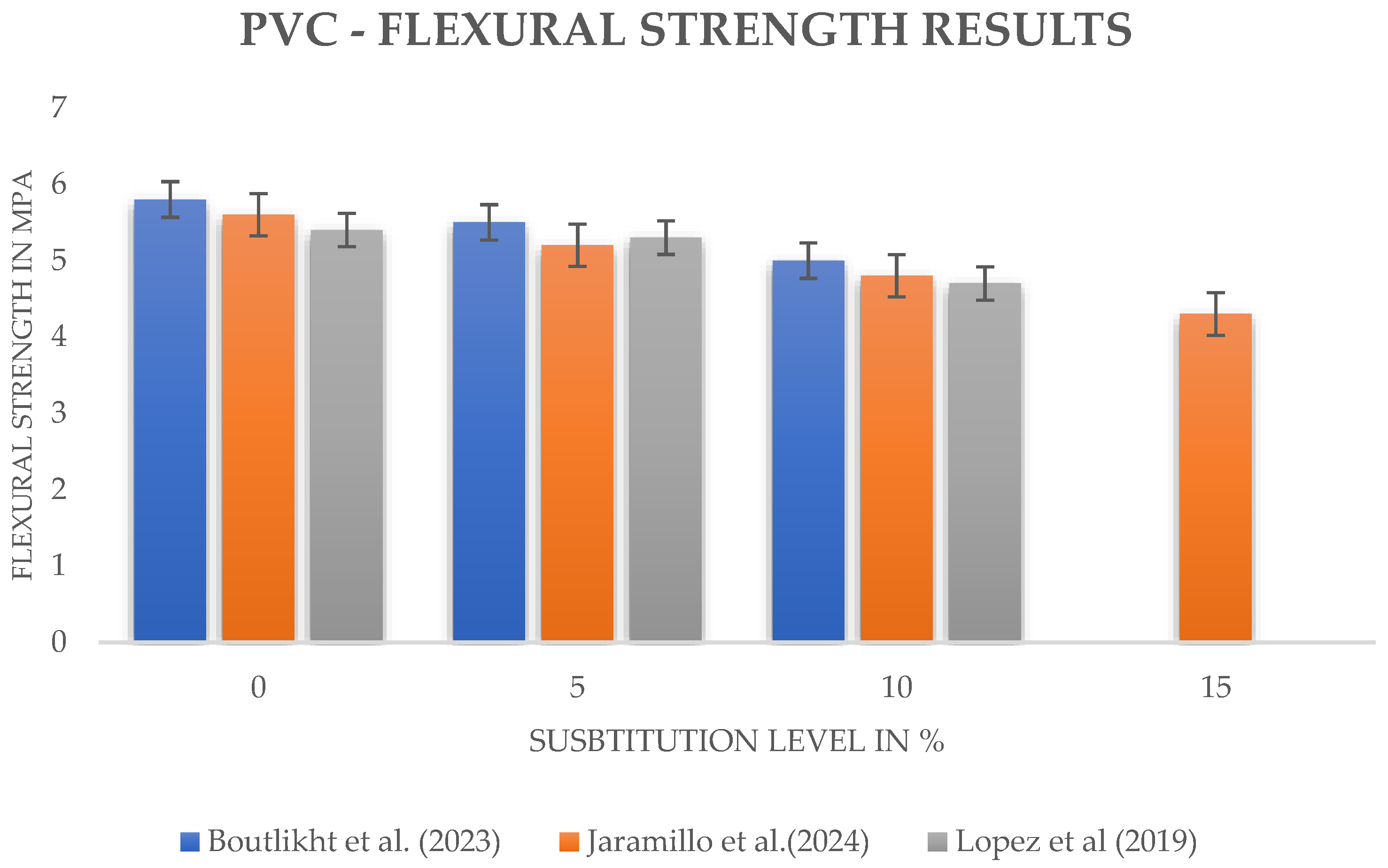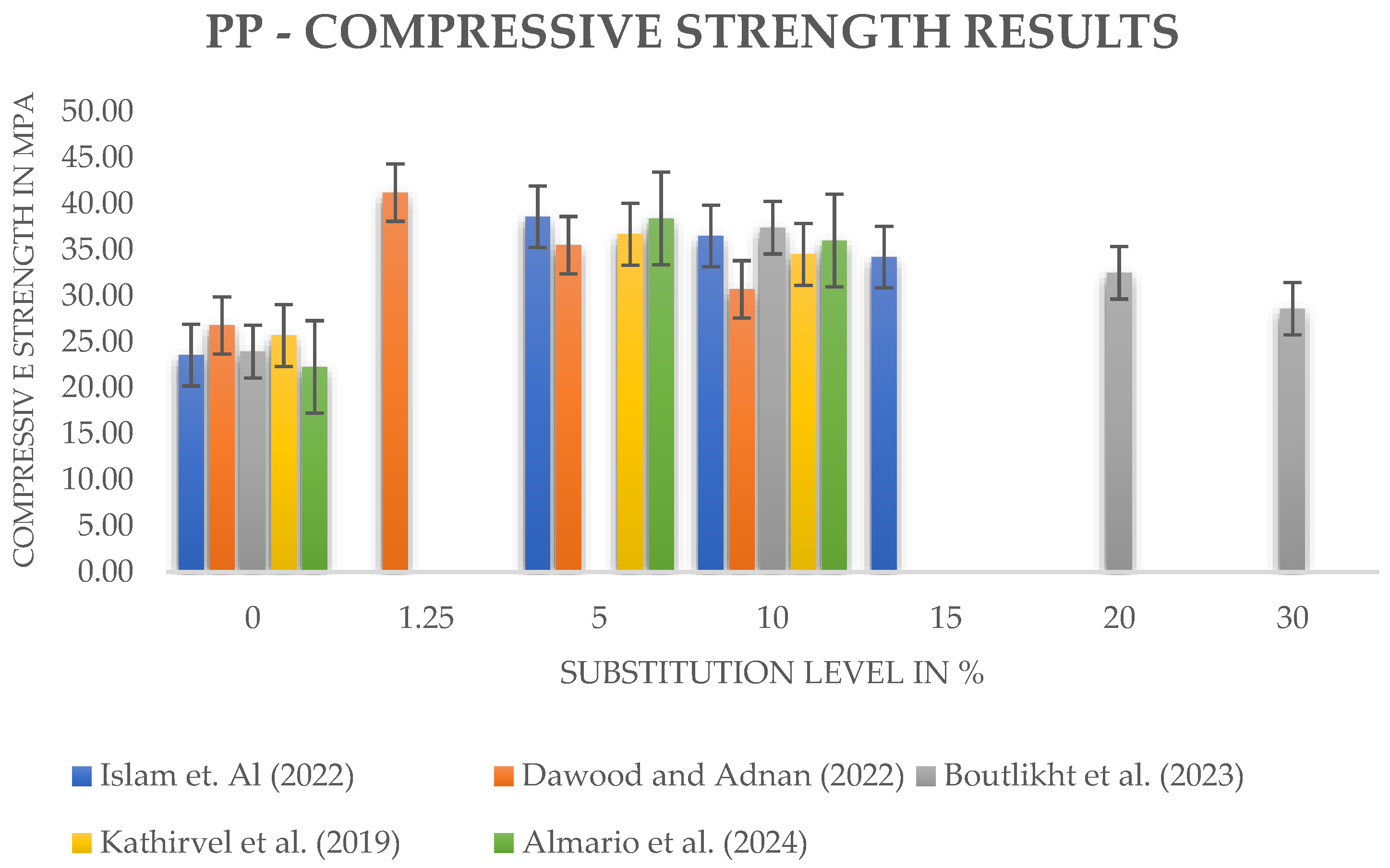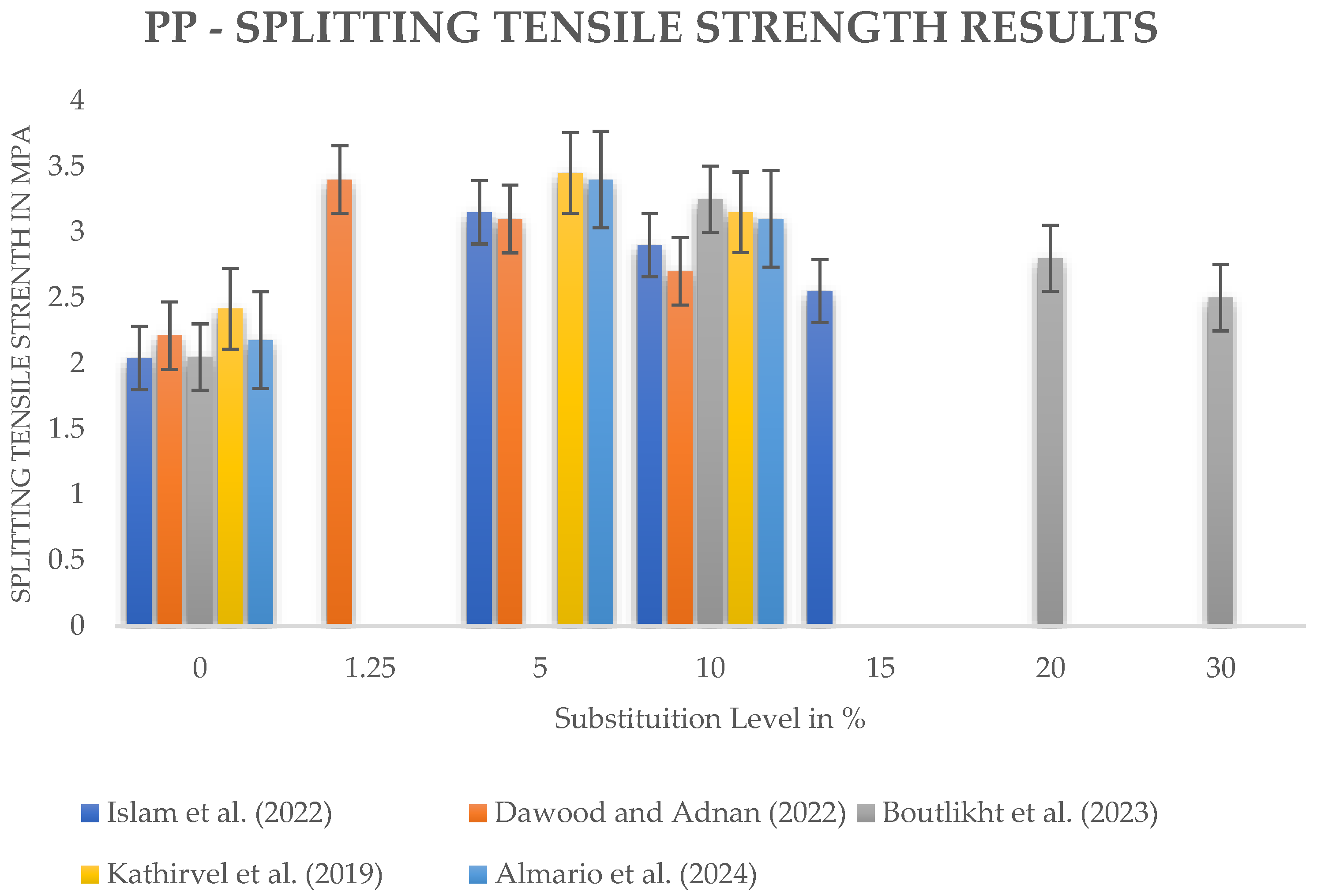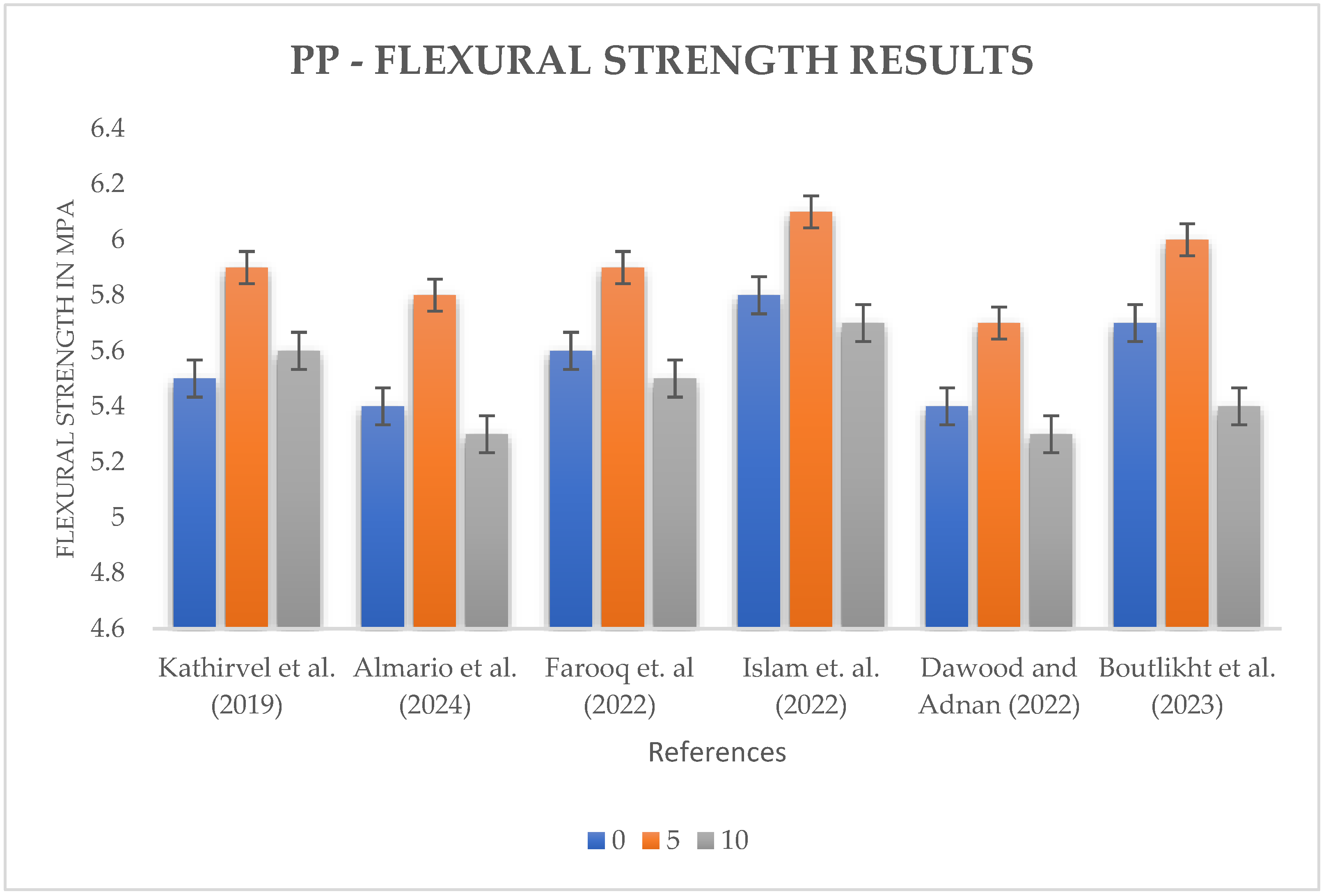3.3.1. High-Density Polyethylene (HDPE)
The use of high-density polyethylene (HDPE) in concrete offers significant environmental benefits, primarily through the reduction of plastic waste and its associated environmental impacts. Plastics, including HDPE, are non-biodegradable and can persist in the environment for hundreds of years, contributing to land and marine pollution. By incorporating HDPE into concrete, the construction industry can help divert large volumes of plastic waste from landfills and waterways, contributing to waste management solutions. This practice aligns with circular economy principles by returning plastic into productive use rather than allowing it to degrade the environment [
25].
The compressive strength of concrete is a crucial factor in determining its structural performance, and incorporating HDPE plastic waste into concrete has shown varying effects on this property depending on the replacement level and other materials used [
27]. Multiple studies have found a clear trend of HDPE in concrete: compressive strength tends to decrease as the amount of HDPE increases. This decline is primarily due to the inherent properties of HDPE, such as its hydrophobic nature and low stiffness compared to traditional coarse aggregates. HDPE plastic tends to reduce the compressive strength of concrete, especially at higher percentages, due to the weak bonding between plastic particles and the cement matrix. The inclusion of HDPE particles introduces voids and air pockets in the concrete mix, which negatively affects its ability to bear compressive loads. However, at 5% HDPE content, the reduction in compressive strength is minor and within acceptable limits for non-structural applications, including rigid pavements, which require moderate compressive strength [
27,
28]. Abbas et al. (2022) supported these findings by reporting that the compressive strength of concrete containing uncoated HDPE was significantly lower than that of conventional concrete. Specifically, the compressive strength values decreased by 21%, 39%, and 47% for HDPE replacement levels of 10%, 20%, and 30%, respectively [
14]. The reason behind this trend is the smooth surface texture and non-porous nature of HDPE, which limit the mechanical interlocking between the aggregate and the cement matrix. The lack of roughness means that HDPE particles act more as inert fillers rather than actively participating in the load-bearing structure of the concrete.
Tensile strength is particularly important for rigid pavements, which are subjected to tensile stresses due to loading from vehicles and environmental effects like temperature fluctuations. Studies have suggested that while compressive strength decreases, the tensile strength of concrete with HDPE can either remain stable or improve slightly at low percentages of plastic addition (around 5%) [
27]. Abbas et al. (2022) investigated the split tensile strength of concrete incorporating uncoated and sand-coated HDPE. The results showed that uncoated HDPE reduced split tensile strength by 16.1%, 30.5%, and 43.7% at replacement levels of 10%, 20%, and 30%, respectively. This reduction in tensile strength is mainly attributed to the hydrophobicity and smooth surface of HDPE, which prevents it from bonding well with the cement matrix [
14].
The performance of HDPE concrete in terms of tensile strength also varies with curing time. Studies have shown that while the 7-day and 14-day splitting tensile strengths of HDPE concrete can be comparable or slightly improved compared to conventional concrete, there is often a clear reduction in tensile strength at 28 days. This reduction is attributed to the weakening bond between HDPE and the cement matrix over time [
27]. This suggests that the long-term performance of HDPE concrete in tension requires careful consideration, especially in applications that rely heavily on tensile properties, such as pavements subjected to significant tensile stresses.
Flexural strength is a critical property in concrete used for rigid pavements because it determines the material’s ability to resist bending stresses caused by vehicular loads, temperature fluctuations, and environmental factors. In rigid pavements, a higher flexural strength indicates that the concrete can withstand these bending forces without cracking, ensuring a longer service life and reducing maintenance costs [
11,
15].
According to Shanmugapriya and Santhi (2017), a 56.4% increase in flexural strength was observed when 10% HDPE (HDPE-10) was incorporated, with the strength peaking at 6.1 MPa. However, beyond this point, the strength declined to 4.7 MPa at HDPE-15, indicating that excessive HDPE content can weaken the concrete’s flexural capacity due to poor bonding between HDPE and the concrete matrix [
15]. Similarly, Biswas (2020) found that flexural strength improved by 54.1% when HDPE content increased from HDPE-0 to HDPE-10, reaching a peak strength of 5.98 MPa, but dropped by 28.9% at HDPE-15, confirming a similar trend [
11].
In line with these findings, Abeysinghe et al. (2021) highlighted that the flexural strength of HDPE concrete generally decreases as HDPE content increases, despite initial gains. The researchers noted that HDPE’s non-reactivity, hydrophobicity, and smooth surface characteristics contribute to weaker bonding between the HDPE particles and the cement paste, which reduces the concrete’s mechanical performance at higher substitution levels. Nonetheless, the study observed that at HDPE-10%, flexural strength increased by 56% compared to HDPE-0 [
29]. Moreover, Badache et al. (2018) also observed that while the flexural strength of HDPE concrete improved slightly at low replacement levels, the strength reduced drastically at higher concentrations of HDPE. Their study showed a flexural strength drop of 1.4 MPa at HDPE-15 and further reductions with increasing HDPE content, supporting previous findings on the weakening effects of excessive HDPE [
30]. Additionally, Lopez et al. (2019) demonstrated that increasing HDPE content from 10% to 20% caused a reduction in flexural strength, highlighting the same challenges of poor interfacial bonding between HDPE and the cementitious matrix [
31].
3.3.2. Low-Density Polyethylene (LDPE)
Among the different types of plastics, low-density polyethylene (LDPE) is one of the most widely produced, commonly used in products such as plastic bags and containers. LDPE, which is non-biodegradable, has persisted in the environment for hundreds of years, making its disposal a significant challenge. Studies have shown that incorporating LDPE into concrete addresses both waste management concerns and raw material shortages in construction, providing a sustainable waste management solution [
31].
Most studies show that LDPE reduces the compressive strength of concrete, particularly when used in higher quantities. This is primarily due to the poor interaction between the LDPE particles and the surrounding cement paste. For instance, research has shown that with an LDPE content of 10%, the compressive strength of the concrete is significantly reduced compared to conventional concrete [
31]. This reduction can range from 20% to 50% depending on the size of the LDPE particles and the over-all mix design.
In the study conducted by Nursyamsi et al. (2019), the compressive strength of light concrete bricks decreased significantly when 20% of the fine aggregate was replaced with LDPE. The compressive strength of the LDPE-modified bricks was 43.05 kg/cm
2, a 57% reduction compared to the control mix’s 100.15 kg/cm
2 [
32]. LDPE does not facilitate the hydration process in the same way as traditional aggregates, resulting in voids and weaker bonds within the concrete matrix. This reduction places the LDPE-enhanced concrete in the lower quality categories based on SNI standards, which is often acceptable for non-structural applications like lightweight bricks but not suitable for load-bearing structures. In a similar study by Setyarini and Tajudin, the stability of asphalt concrete mixtures increased by 63.75% when 7% LDPE was used as an aggregate coating. However, this enhanced stability did not translate into improved compressive strength, as the material remained less suitable for high-load applications [
33].
The inclusion of LDPE in concrete typically results in a reduction in tensile splitting strength due to the weak bonding between the hydrophobic LDPE particles and the cement matrix. Several studies have highlighted the behavior of LDPE-modified concrete under tensile splitting tests, with varying outcomes based on the proportion of LDPE added and the size and shape of the plastic particles. In one study, when LDPE plastic waste was used to replace fine aggregate at levels of 5%, 10%, and 20%, the tensile splitting strength decreased as the LDPE content increased. The tensile strength dropped by as much as 45.15% when 20% LDPE was used in place of fine aggregate [
33].
To maintain tensile performance while benefiting from the environmental advantages of using LDPE, researchers have identified an optimal LDPE content of 5% to 10% by weight. At these levels, the reduction in tensile splitting strength is more manageable, and the concrete retains enough strength for non-structural applications such as lightweight pavement blocks and sidewalks [
33]. Lower percentages of LDPE (e.g., 5%) have been shown to reduce tensile strength by a smaller margin, while higher percentages (10–20%) lead to more significant reductions. The study by Saikia and De Brito (2014) confirmed that 5% LDPE maintains a reasonable balance between tensile strength and the material’s ability to resist cracking [
12].
Studies have consistently shown that incorporating LDPE into concrete results in a decrease in tensile splitting strength. This reduction is primarily due to the poor bond between the hydrophobic LDPE particles and the cement paste, which weakens the overall concrete matrix. A study by Vivek et al. (2023) examined the replacement of fine aggregates with 5%, 10%, 15%, and 20% LDPE in M20-grade concrete. It was observed that tensile strength reduced significantly as the percentage of LDPE increased. For instance, the split tensile strength of the concrete with 20% LDPE was measured at 0.92 MPa, compared to 2.18 MPa for the control mix without LDPE. This showed a reduction of approximately 57.8% in tensile strength, highlighting the negative impact of a higher LDPE content on the material’s ability to withstand tensile forces [
13].
The incorporation of LDPE into concrete has been shown to affect its flexural strength, with results varying depending on the percentage of LDPE used and the specific characteristics of the plastic. LDPE, being a more flexible and lightweight plastic, generally results in a reduction in flexural strength when added to concrete. For instance, in a study by Radhi et al. (2021), it was found that the flexural strength decreased with increasing LDPE content. At 5% LDPE substitution, the flexural strength of concrete showed only a marginal reduction, but at 10% and 15% substitution levels, the decrease became more significant, with the strength dropping by approximately 20% compared to the control mix. The researchers concluded that LDPE’s lack of proper bonding with the cement matrix weakens the ability of the concrete to withstand flexural stresses [
28]. Similarly, Mourad Boutlikht et al. (2023) reported a reduction in flexural strength as the percentage of LDPE increased. Their study demonstrated that the flexural strength decreased by around 15% when 10% LDPE was incorporated, and this reduction reached nearly 30% at a 20% LDPE substitution. The authors attributed this to the reduced adhesion between the smooth LDPE particles and the surrounding cement paste, which diminishes the overall load-carrying capacity of the concrete under bending stresses [
18].
3.3.3. Polyvinyl Chloride (PVC)
PVC is commonly used in pipes, cables, and window frames, and incorporating it into concrete reduces the reliance on natural aggregates while addressing plastic waste disposal issues. However, the inclusion of PVC in concrete significantly affects its mechanical properties, particularly compressive strength and tensile strength.
Research consistently shows that incorporating PVC waste into concrete affects compressive strength, often leading to a reduction in strength as PVC content increases. The hydrophobic nature of PVC limits its bonding ability with the cement paste, creating weak points in the matrix that compromise load-bearing capacity. For instance, a study by Boutlikht et al. (2023) found that increasing the percentage of PVC as a sand replacement beyond 5–10% led to a significant decrease in compressive strength due to the poor adhesion between the PVC particles and cement [
18]. However, at lower levels (up to 10%), the mechanical properties remained within acceptable limits for non-structural applications, highlighting the importance of controlling the PVC content to balance sustainability and performance [
32].
Similarly, study by [
34] found that using 1.25% WP in concrete mixtures resulted in a 31.66% increase in compressive strength, demonstrating that at low concentrations, plastic can positively affect concrete performance. However, as the waste plastic content increased to 5%, the compressive strength decreased, indicating that benefits are highly contingent on keeping its proportion in the mix relatively low [
10].
The percentage of PVC used in a concrete mixture is a major determinant of the material’s tensile splitting strength. Research consistently shows that the tensile strength decreases as the PVC content increases, primarily due to weak bonding between the hydrophobic PVC particles and the cement paste. This weak bond causes stress concentrations at the PVC–cement interfaces, leading to premature cracking under tensile loads. For example, [
34] found that using 1.25% waste plastic resulted in a 6.45% increase in tensile splitting strength, demonstrating that small amounts of PVC can improve tensile performance [
10]. In another study, it was observed that using fine PVC particles as a replacement for sand in the concrete mix led to a more pronounced reduction in tensile strength compared to using PVC fibers. Fine PVC particles increased the void content and weakened the concrete’s internal structure, causing a greater loss of tensile performance [
32].
In a study by [
35] it was found that incorporating 5% PVC waste into concrete resulted in a slight improvement in flexural strength, reaching 5.2 MPa, compared to the control mix. However, as the PVC content increased to 10%, the flexural strength began to decrease to 4.8 MPa, and at 15%, it further dropped to 4.3 MPa. The authors attributed this decline to poor bonding between the PVC particles and the cement matrix, which reduces the material’s load-bearing capacity under bending stresses [
32]. Their findings showed that PVC-modified concrete exhibited an optimal flexural strength at lower levels of substitution, making it suitable for applications where bending resistance is critical [
6].
3.3.4. Polypropylene (PP)
The incorporation of PP in concrete has gained attention due to its potential to enhance the mechanical properties of concrete while promoting sustainability by recycling plastic waste. PP is a thermoplastic polymer widely used in various industries and is often explored as a replacement for natural aggregates or as fiber reinforcement in concrete.
Research consistently shows that the compressive strength of concrete generally decreases as the proportion of polypropylene increases, especially at higher replacement levels. This reduction is primarily due to the hydrophobic nature of polypropylene, which leads to poor bonding between the PP particles and the cement paste. The weak interfacial transition zones (ITZs) between the polypropylene and the cement matrix result in reduced load-bearing capacity and the formation of microcracks. For example, a study by Md. Jahidul Islam found that incorporating 10% polypropylene as a coarse aggregate replacement led to a 39% increase in compressive strength compared to conventional concrete. However, beyond 10%, the compressive strength decreased due to the reduced adhesion between the PP and cement matrix [
35]. This trend was also observed in other studies where the inclusion of polypropylene fibers or recycled polypropylene waste reduced compressive strength as the percentage of PP increased, particularly beyond 20% [
35].
In a study involving polypropylene pellets, the optimal replacement level for compressive strength was found to be 20%, where the compressive strength increased by 31.75% compared to the control mix [
6]. However, at replacement levels exceeding 20%, the compressive strength declined due to increased porosity and void formation, as PP’s hydrophobic properties prevented proper bonding with the cement paste, leading to weak spots in the matrix.
The inclusion of polypropylene in concrete tends to improve tensile strength at lower replacement levels, but excessive amounts can lead to a reduction in tensile performance. The optimal range for improving tensile splitting strength generally falls between 5% and 20%, depending on the form of polypropylene. For instance, the study conducted by Md. Jahidul Islam demonstrated that using 10% polypropylene waste as coarse aggregate resulted in minimal reduction in tensile strength, while higher proportions (20% or more) caused a more noticeable decline due to poor bonding between the PP and the cement matrix [
35]. Similarly, the incorporation of polypropylene pellets at 20% replacement led to a 12.98% increase in tensile splitting strength compared to the control mix, making it an ideal replacement level for improving tensile performance [
35]. However, tensile strength began to decline beyond 20%, likely due to increased void formation and the hydrophobic nature of polypropylene, which limits its bonding with the cement.
In the case of polypropylene fibers, the study by Dawood and Adnan (2022) showed that a small proportion of 1.25% PP fibers led to a 6.45% increase in tensile splitting strength, as the fibers helped delay the propagation of cracks [
10]. However, when the PP fiber content exceeded 5%, the tensile strength began to drop, indicating that excessive fiber content may reduce the cohesion of the concrete matrix.
Polypropylene fibers have a notable impact on flexural strength due to their crack-bridging capacity, which delays crack initiation and propagation under flexural loads. A study by Boutlikht et al. (2023) found that adding polypropylene fibers at 10–20% improved the concrete’s flexural strength, particularly at lower replacement levels, where the fibers distributed stresses more effectively [
18]. The improvement was attributed to the fiber’s ability to enhance the toughness and ductility of the concrete, making it more resilient under bending forces.
In the study on polypropylene pellets, flexural strength showed the most significant improvement at 30% replacement, where a 34.8% increase in flexural strength was observed compared to conventional concrete [
6]. This high increase indicates that PP pellets can be highly effective in applications where bending forces dominate. However, this improvement was seen specifically with pellets, as their shape and size allow them to distribute bending stresses across the matrix more evenly than irregular or fine aggregates.
Recycled polypropylene waste, when used as a coarse aggregate replacement, exhibited more moderate improvements in flexural strength. The study showed that concrete with 10–20% recycled PP exhibited comparable flexural strength to conventional concrete, suggesting that recycled polypropylene can be used without significantly compromising the material’s performance under flexural loads [
5]. Similarly, the use of polypropylene pellets at a 30% replacement showed the highest increase in flexural strength due to the pellets’ ability to distribute flexural stresses more effectively across the concrete matrix [
6]. The pellets act as stiff inclusions that help support the matrix during bending, improving the overall toughness of the material.
